 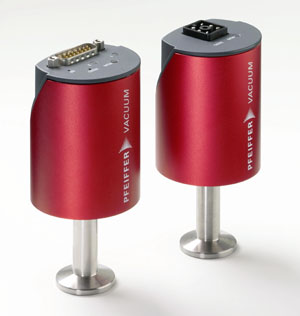
CMR ActiveLine Vacuum Gauges
Pfeiffer Vacuum CMR capacitance manometers offer compact and rugged vacuum measurement from 10-5 to 1100 mbar. A ceramic sensor prevents memory effect and resists corrosive gases. Learn More.
Pfeiffer Vacuum, Inc.
Phone: 800-248-8254
Web site: www.pfeiffer-vacuum.com
contact@pfeiffer-vacuum.com
|
 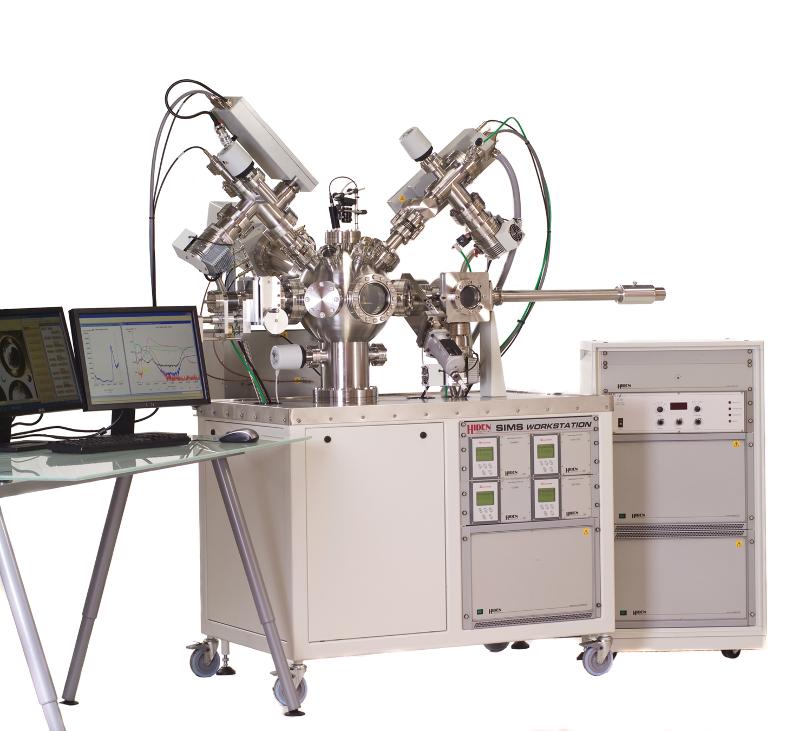 SIMS Workstation SIMS Workstation
A high performance SIMS instrument for:
- Thin film depth profiling
- Surface imaging
- Features new high sensitivity sputtered neutrals detection mode for quantitative analysis. Learn more.
E-mail address: info@hiden.co.uk
|
 
VAT's REAL L-MOTION VALVE
For SEMI and LED
Check out VAT's redesigned website for the latest news about VAT's 450mm Transfer Valves and other VAT happenings. Visit us at AVS in Florida!
Contact Us:
Phone: 781-935-1446
or 800-935-1446
|
 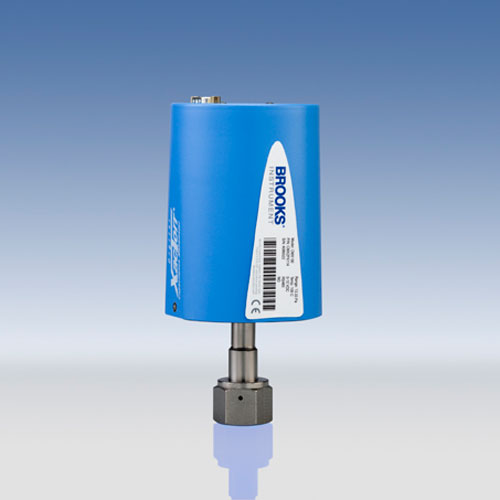
Capacitance Manometers that Last
...Up to 3x Longer
The rugged design of the Brooks XacTorr handles byproduct build-up, lasting up to three times longer even in aggressive processes. Learn more.
Brooks Instrument
Phone: 215.362.3700
Email:
BrooksAM@BrooksInstrument.com
|
 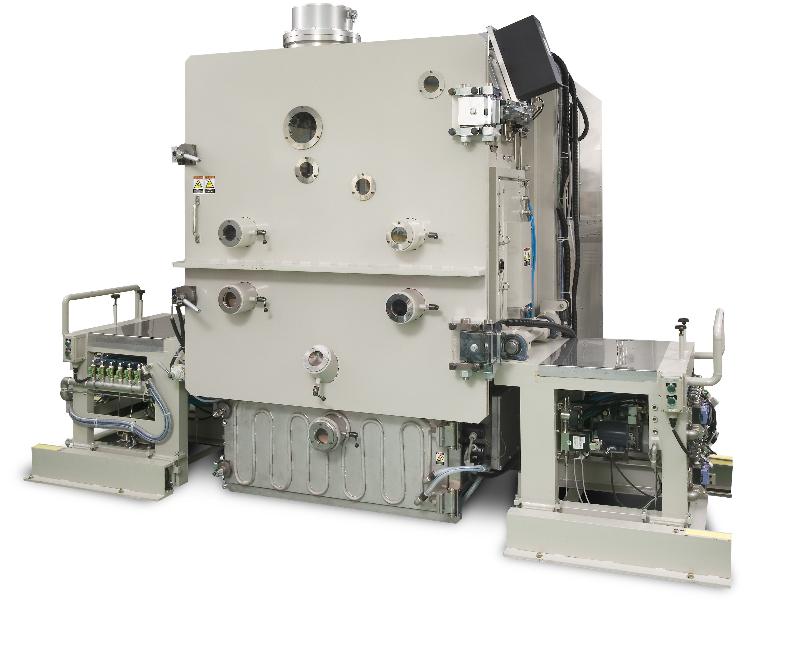
ULVAC's SPW-030 roll coating system is capable of processing 300 mm wide substrate compositions including thin-gauge metal rolls and polymeric materials for R&D and Pilot-scale production. Learn More.
ULVAC Technologies, Inc. Visit Us Online Tel: 1-978-686-7550
E-mail: sales@us.ulvac.com |

Automatic Valve Controller
The INTELLITROL series of automatic valve controllers provide total control of vacuum operations. It offers fully automatic, protected manual mode and service mode for complete manual operation. Learn More.
YTI Thin Film Products and Services
Phone: 860.429.1908
Intellitrol@ytionline.com
www.ytionline.com
|
 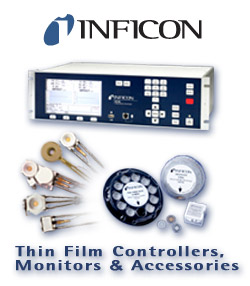
INFICON thin film deposition controllers, monitors and accessories, including customizable sensors and feedthroughs, offer features, function and value targeted to your application. View our catalog and contact us today! |
 
Rebuilt Feedthroughs
Rigaku rebuilds ferrofluid feedthroughs for all leading manufacturers and offers a warranty on rebuilt units. Most parts are stocked in inventory for fast turnaround. Learn More.
Rigaku Vacuum Products
E-mail: vacuum-info@rigaku.com
Phone: 603-890-6001
|

Got a Handle on Destructive Arcing? Comdel Can Help.
Comdel's VF Series Multiple Channel Synthesizers provide phase adjustable output to avoid destructive arcing and cross-talk in multiple cathode plasma processing chambers, and allows adjustment for cable length dependencies. Learn more.
|

From AR Coatings to Notch Filters, and from TCOs to DBRs, Evatec offers customized coating platforms and complete process solutions based on enhanced evaporation and sputter.
Phone: (603) 669-9656
www.evatecnet.com
E-Mail:infoNA@evatecnet.com
|
 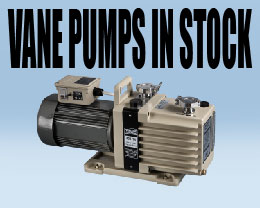
Vane Pumps In Stock
3 to 64 CFM, 6 to108 m3/hour. All voltages, 1 and 3 phase. Fomblin/Krytox available. 2 year parts & labor warranty, satisfaction guaranteed.
Vacuum Research Corporation Phone: 800/426-9340
Web: www.vacuumresearch.com
E-Mail: vrc@vacuumresearch.com
|
 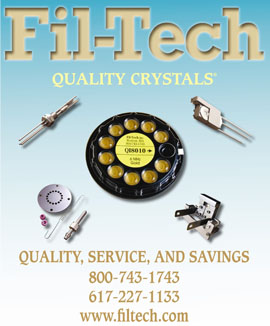
Fil-Tech's Quality Crystals® Gold, Longer Life Gold, and Alloy 6MHz and 5MHz styles. Fil-Tech supplies rate monitors, sensorheads, feedthroughs, ebeam and ion source parts. Fil-Tech's FT704 replaces DC704. Call for catalog and Technical Bulletins.
Fil-Tech, Inc. 617-227-1133 or 800-743-1743 www.filtech.com |
 
Solid Sealing Technology designs and manufactures hermetic assemblies using metalizing, brazing and glass-ceramic sealing including standard and custom Feedthroughs/Connectors for extreme environments and UHV.
Contact:
Ph: 518-874-3600
Fax: 518-874-3610
info@solidsealing.com
|
 
THREE STEPS TO SUCCESS
Power Mag Technologies now offers 3 different power levels of DC Magnetrons to enhance your sputtering process with the Maxim line of power supplies.
Contact: 877.513.3295
|
 
Thin-Films Research is prepared to meet your custom thin-film coating requirements. Using state-of-the-art equipment and over 40 years of experience, Thin-Films Research offers technology for the electro-optics, semiconductors, sensors & medical electronic industries. Learn More
Thin-Films Research, Inc.
270 Littleton Road
Westford, MA 01886
Phone: 978-692-9530
Fax: 978-692-9531
E-Mail: sales@thinfilmsresearch.com |

Next Live Webinar
"Troubleshooting for Thin Film Deposition Processes"
Tuesday, December 11, 2012
9:00 am - Noon, Mountain Time
with Gary S. Ash
Castle Brook Corporation
Register Now
Space is Limited
___________________________
Explore the entire SVC Webinar library, both Live and On-Demand Formats
Learn More!
|
|
|

|
|
DLC Coatings Enhance IR Cameras
|
From Photonics Spectra, September 2012, by Mordechai Gilo, Ophir Optronics Ltd.: "In IR cameras, the effect of a detector's reflection on the detector itself is named after Narcissus. The magnitude of the effect is directly influenced by the reflectance of the antireflection (AR) coating of the front lens. The front lens usually has to withstand the harsh environmental requirements of an external part. The most suitable coating is a hard carbon (HC) or diamondlike carbon (DLC) coating.
The standard DLC coating is a single layer of carbon atoms with a mixture of SP3 (diamond) and SP2 (graphite) bonds. The average  reflection is too high, resulting in a noticeable Narcissus effect. There are many ways to produce DLC coatings, including CVD. reflection is too high, resulting in a noticeable Narcissus effect. There are many ways to produce DLC coatings, including CVD.
A new type of coating - low-reflection hard carbon (LRHC) - from Ophir Optronics Ltd. is a multilayer coating with a DLC overcoat layer designed to have a low reflection. The design considerations were: 1) A dielectric layer with either a Si or Ge top layer would be coated in a PVD coating chamber. 2) The DLC layer would be added in a plasma-enhanced CVD chamber. 3) The DLC layer thickness had to be minimized to reduce internal absorption but to maintain a minimal thickness to achieve the required durability. The Narcissus effect was not seen and coatings passed the durability tests."
Source: Read the full article...
Photonics Spectra: http://photonics.com/Article.aspx?AID=51734
Image: Photonics Spectra
|
|
New Record for Photovoltaic Solar Cells
|
From École Polytechnique Federale de Lausanne (EPFL, Switzerland), September 28, 2012, by Emmanuel Barraud: "EPFL's Institute of Microengineering presented in Frankfurt "hybrid" photovoltaic cells with an energy conversion efficiency of 21.4%, the highest obtained for the type of substrate they used. This breakthrough will contribute to lower the cost of solar cell based installations. They apply a 0.01 micron layer of  amorphous silicon on both sides of a crystalline silicon wafer. This "sandwich" conception contributes to increase the sensors' effectiveness. They obtained a 21.4% conversion efficiency, which had never been achieved before with such type of substrates. These results, validated by the Fraunhofer Institute for Solar Energy Systems (ISE) in Germany, will soon be published by the IEEE Journals of Photovoltaics. This research was partly financed as a commission for Roth & Rau Switzerland, whose parent company, Meyer Burger, has already started the commercialization of machines built for assembling this type of heterojunction cell."
Source: Read the full article...
|
|
More 2-D Materials like Graphene
|
From Chemical and Engineering News, October 8, 2012, by Mitch Jacoby: "When it comes to atomically thin or nearly atomically thin materials, graphene isn't the only game in town. Researchers are investigating the fundamental properties of new 2-D materials and devising methods for preparing them in large quantities." This article provides an overview of seceral new ulta-thin crystals, such as "boron nitride, molybdenum disulfide and metal carbides." *Two molecular thick MoS2was formed using the lithography methods and vapor deposition techniques to deposit various types of metal electrodes and isolated them from one another with insulating films of hafnium oxide.
*A few atoms thick hexagonal-BN crystal is created when an "electron beam sweeps away one atomic layer at a time by forming vacancies."
*Two molecular layers thick of Ti3AlC2 are formed by chemical exfoliation with hydrofluoric acid. Seven new materials were formed using this method. Source: Read the full article...
|
2013 SVC TechCon Promotional Partners
|
The following publications and organizations are playing an important role promoting the 2013 SVC TechCon within and outside the vacuum coating community.
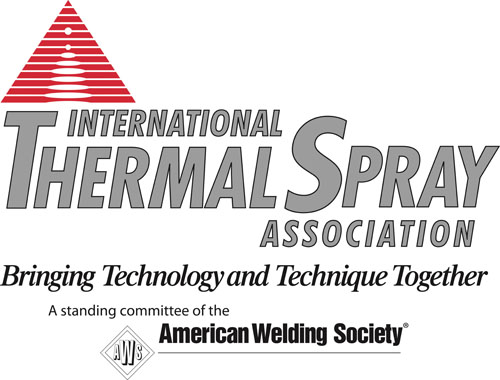 Something for everyone - 25,000 attendees and 1100 exhibitors with a Thermal Spray Conference and a Thermal Spray Pavilion! Register soon for the Fabtech Thermal Spray Conference. (Registration code W29 - $345.00 ITSA or AWS member, $480.00 non-member). The free half-day thermal spray tutorial registration code is W30 (Monday, November 12 from 1:00-5:00 pm). Visit Online: Fabtech Expo
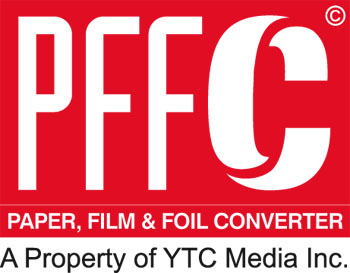 PFFC (Paper, Film & Foil Converter) reaches converters of flexible/semi-rigid materials that print, coat, laminate, metallize, extrude, slit, die-cut, and make bags/pouches, labels, tapes, tags, cartons, boxes, fiber tubes, magnetic media, sanitary, and disposable products. Features: case histories, technical articles, expert columns, news/events, new products, and videos. Comprehensive online Buyer's Guide complements weekly E-Clips e-newsletter. PFFC (Paper, Film & Foil Converter) reaches converters of flexible/semi-rigid materials that print, coat, laminate, metallize, extrude, slit, die-cut, and make bags/pouches, labels, tapes, tags, cartons, boxes, fiber tubes, magnetic media, sanitary, and disposable products. Features: case histories, technical articles, expert columns, news/events, new products, and videos. Comprehensive online Buyer's Guide complements weekly E-Clips e-newsletter.

Tomorrow's vacuum and solar innovations start with the researchers who read Physics Today. 52% of our 120,000 readers list their primary job function as research. The subset of readers who buy vacuum systems and components is 29,403. We look forward to sponsoring SVC's Exhibitor Lounge again in 2013.
See all the 2013 SVC TechCon Promotional Partners Here. If you are Interested in promoting the SVC 2013 TechCon to your readers or members, contact publications@svc.org for details on becoming a Promotional Partner.
|
|
Polytechnique Montréal and Seven Partners Inaugurate the Largest NSERC Research Chair in Coatings and Surface Engineering
|
From Polytechnique Montréal, September 25, 2012: "Polytechnique Montréal, the Natural Sciences and Engineering Research Council of Canada (NSERC) and seven industry partners inaugurated today the NSERC Multisectorial Industrial Research Chair in Coatings and Surface Engineering (MIC-CSE). As the country's second-largest industrial research chair awarded by the NSERC, all fields combined, the MIC-CSE will benefit from a budget of $5.35 million over five years from NSERC ($2.6 million), and from seven partners (a total of $2.75 million): Essilor, Hydro-Québec, Guardian Industries Corp., Pratt & Whitney Canada, Velan, JDS Uniphase and the Canadian Space Agency." Ludvik Martinu, Professor in the Department of Engin 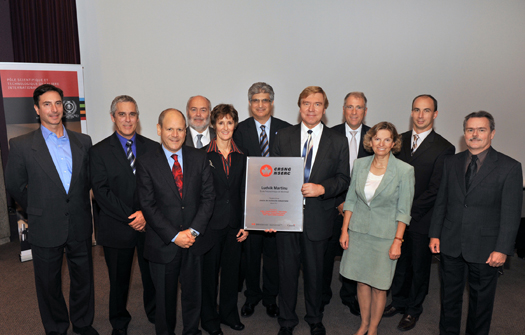 eering Physics at Polytechnique Montréal has been named MIC-CSE Chairholder. Professor Martinu is also the current president of the Society of Vacuum Coaters. "Research will focus on developing a new generation of non-polluting manufacturing technologies for nanostructured coating materials. These processes make it possible to add successive layers of nanometre-thick films and thicker coating architectures using various materials (metals, ceramics, polymers, nanoparticles or others) on to flat surfaces as well as on three-dimensional objects. Far from being limited to corrosion and wear protection, these "molecular millefeuilles" aim to confer a wide range of functional characteristics to the surfaces: anti-glare, anti-erosion, anti-fog, but also self-controlled (or "smart") optical reflectivity or emissivity, luminescence, sterility and more." Source: Read the full article... Polytechnique Montréal: http://www.polymtl.ca/carrefour/en/article.php?no=3976 Image: Polytechnique Montréal
|
|
PixelTec Patterned Optics Available with High-Precision Bandpass Filters
|
From Nanowerk.com, October 1, 2012, from Ocean Thin Films: " Ocean Thin Films now provides its patented PixelTec™ patterned optical coating process for high-precision bandpass filters, opening up new possibilities for application-specific cameras. The extended capability enables optical devices to be micro-patterned with multiple narrow-band filters, creating even greater contrast and resolution for multispectral applications from cellular microscopy to factory vision systems.
By combining state-of-the art sputtered coating expertise with exclusive microlithography technology, PixelTec delivers highly accurate geometric and spectral performance across the ultraviolet (UV), visible and near - short wave infrared ranges (NIR - SWIR)." Source: Read the full article...
|
|
Dynavac Plays a Pivotal Role in Capturing "First Light" from the New Discovery Channel Telescope
|
From Dynavac, September 24, 2012: " Dynavac, a market leader in precision optical coating systems, engineered and manufactured the optical coating system for the Lowell Observatory's newly commissioned flagship telescope: the Discovery Channel Telescope (DCT), the fifth largest optical telescope in the continental United States.
Dynavac is one of a handful of companies in the world with the capabilities to design, engineer and manufacture the mirror deposition system for the 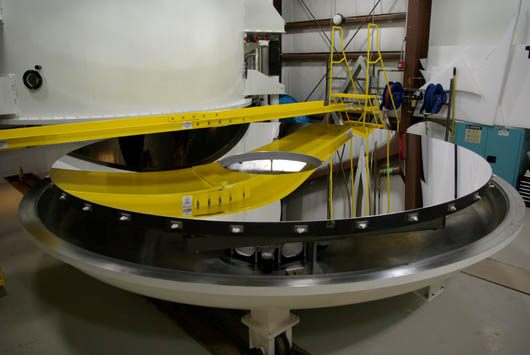 four-meter class "super-scope" telescope. Light from the universe reflects off the DCT's primary and secondary mirrors, and it is Dynavac's thin film deposition and vacuum technologies that created the reflective, aluminum surfaces of the giant mirrors. Dynavac also co-sponsored the First Light Gala commissioning the telescope, and is featured in the Discovery Channel's documentary, 'Scanning the Skies: The Discovery Channel Telescope.'" four-meter class "super-scope" telescope. Light from the universe reflects off the DCT's primary and secondary mirrors, and it is Dynavac's thin film deposition and vacuum technologies that created the reflective, aluminum surfaces of the giant mirrors. Dynavac also co-sponsored the First Light Gala commissioning the telescope, and is featured in the Discovery Channel's documentary, 'Scanning the Skies: The Discovery Channel Telescope.'"
Source: Read the full article...
|
|
Nanoscale Imaging of Strain using X-Ray Bragg Ptychography
|
From Argonne National Laboratory, October 2012, S.O. Hruszkewycz et al.: "The theoretical and experimental framework of a new coherent diffraction strain imaging approach was developed in the Center for Nanoscale Materials' X-Ray Microscopy Group in collaboration with Argonne's Materials Science Division, together with users from IBM. Nanofocused X-ray Bragg projection ptychography creates a tool to efficiently image strain fields with unperturbed boundary conditions in technologically and scientifically relevant energy systems.
This new technique is capable of imaging lattice distortions in thin films nondestructively at spatial resolutions of <20 nm using coherent nanofocused hard X-rays. This work marks a significant step forward in the development of nondestructive coherent X-ray diffraction imaging techniques for the study of nanoscale lattice features in real materials under real conditions."
Source: Read the full article...
Argonne National Laboratory: http://nano.anl.gov/news/highlights/2012_ptychography.html
|
|
Space-Age Materials One Atomic Layer at a Time
|
From NASA Goddard Space Flight Center, August 10, 2012: "Although engineers have developed different techniques to safeguard spacecraft from micrometeorites, solar particles, and space junk - everything from spent rocket stages to paint fragments - zipping past satellites at up to 12.4 miles (20 kilometers) per second, nothing provides 100-percent protection for sensitive spacecraft optics, detectors, and solar panels
A technologist at NASA's Goddard Space Flight Center in Greenbelt, Md., however, is experimenting with an emerging technology that might provide another, perhaps more effective, technique for defending sensitive spacecraft components from the high-velocity bombardments.
Vivek Dwivedi and his collaborator, chemical engineering professor
Ra ymond Adomaitis from the University of Maryland, College Park, are using atomic layer deposition (ALD) - a rapidly evolving technology for coating plastics, semiconductors, glass, Teflon, and a plethora of other materials - to create a new super-strong, ultra-thin coating made of tiny tubes of boron nitride, similar in appearance to the bristles on a toothbrush. ymond Adomaitis from the University of Maryland, College Park, are using atomic layer deposition (ALD) - a rapidly evolving technology for coating plastics, semiconductors, glass, Teflon, and a plethora of other materials - to create a new super-strong, ultra-thin coating made of tiny tubes of boron nitride, similar in appearance to the bristles on a toothbrush.
'Crystalline boron nitride is one of the hardest materials in the world,' Dwivedi said, making it ideal as a coating to make sensitive spacecraft component less susceptible to damage when struck by space dust, tiny rocks, and high-energy solar particles."
Source: Read the full article...
NASA:http://www.nasa.gov/topics/technology/features/atomic-layer.html
Image: NASA/GSFC/Chris Gunn
|
|
ORNL Research Uncovers Path to Defect-Free Thin Films
|
From Oak Ridge National Laboratory, Sept. 20, 2012: "A team led by Oak Ridge National Laboratory's Ho Nyung Lee has discovered a strain relaxation phenomenon in cobaltites that has eluded researchers for decades and may lead to advances in fuel cells, magnetic sensors and a host of energy-related materials.
The finding, published in Nano Letters, could change the conventional wisdom that accommodating the strain inherent during the formation of epitaxial thin films necessarily involves structural defects, said Lee, a member of the Department of Energy lab's Materials Science and Technology Division. Instead, the researchers found that some materials, in this case cobaltite, form structurally well ordered atomic patterns that can change their magnetic properties and effectively minimize the size mismatch with the crystalline substrate."
Source: Read the full article...
Oak Ridge National Laboratory: http://www.ornl.gov/info/press_releases
/get_press_release.cfm?ReleaseNumber=mr20120920-00
|
|
New Crack Prevention Method for Nanoparticle Thin Films
|
From AZONano.com, October 12, 2012, by upenn.edu: "Making uniform coatings is a common engineering challenge, and, when working at the nanoscale, even the tiniest cracks or defects can be a big problem. New research from University of Pennsylvania engineers has shown a new way of avoiding such cracks when depositing thin films of nanoparticles.
To generate a nanoparticle film, the desired particles are suspended in a suitable liquid, which is then thinly and evenly spread over the surface through a variety of physical methods. The liquid is then allowed to evaporate, but, as it dries, the film can crack like mud in the sun. 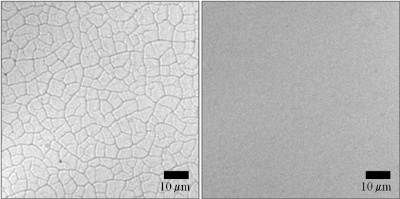 'One method for preventing cracking is modifying the suspension's chemistry by putting binding additives in there,' Prosser said. 'But that is essentially adding a new material to the film, which may ruin its properties.'" 'One method for preventing cracking is modifying the suspension's chemistry by putting binding additives in there,' Prosser said. 'But that is essentially adding a new material to the film, which may ruin its properties.'"
Source: Read the full article...
|
|
A Cheaper Way to Produce NFO Thin Films
| From North Carolina State University, September 25, 2012: "Researchers from North Carolina State University and the Georgia Institute of Technology have demonstrated a less-expensive way to create textured nickel ferrite (NFO) ceramic thin films, which can easily be scaled up to address manufacturing needs. NFO is a magnetic material that holds promise for microwave technologies and next-generation memory devices.
Specifically, this is the first time researchers have used a chemical deposition process to create NFO thin films that are "textured" - meaning they have an aligned crystalline structure. Arraying the crystalline structure in an orderly fashion is important because it maximizes the magnetic properties of the material."
Source: Read the full article...
|
|
Freezing Electrons in Flight
| From University of Arizona News, October 12, 2012, by Daniel Stolte: "Using the world's fastest laser pulses, which can freeze the ultrafast motion of electrons and atoms, UA physicists have caught the action of molecules breaking apart and electrons getting knocked out of atoms. Their research helps us better understand molecular processes and ultimately be able to control them in many possible applications.
 Using extreme ultraviolet light bursts lasting 0.0000000000000002 seconds - that's 200 quintillionths of a second - Arvinder Sandhu and his team have managed to freeze the unimaginably fast action that ensues when oxygen molecules are zapped with high energies for incredibly short amounts of time. Observing ultra-short events in atoms and molecules has become increasingly important as scientists are trying to gain a better understanding of quantum processes on the level of electrons, and ultimately even control those processes to design new light sources, assemble new molecules, or engineer new ultrafast electronic devices, among countless other possibilities."
Source: Read the full article...
|
|
Do You Have an Interesting Article to Share?
|
Interested in sharing the latest news in vacuum coating technology? Forward us a link to an article you want to share with the rest of the SVC readership to publications@svc.org. Purchase advertising space in this newsletter by contacting SVC at 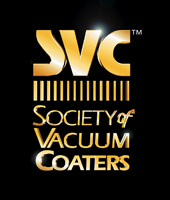 svcinfo@svc.org. svcinfo@svc.org.
Society of Vacuum Coaters
71 Pinon Hill Place NE
Albuquerque, New Mexico 87122
505-856-7188
|
|
|
|
|